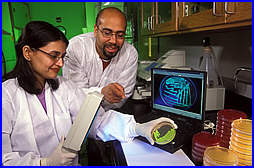



Models Predict Poultry Pathogen Behavior
US - Computer models that more accurately predict the growth of food pathogens are being developed by the Agricultural Research Service (ARS) and are available online. These models make better predictions about food safety because they gauge how pathogens are affected by competition from other food microbes.
Models Predict Poultry Pathogen Behavior - US - Computer models that more accurately predict the growth of food pathogens are being developed by the Agricultural Research Service (ARS) and are available online. These models make better predictions about food safety because they gauge how pathogens are affected by competition from other food microbes.
ARS food technologist Thomas P. Oscar, at the ARS Poultry Food Safety Research Laboratory in Princess Anne, Md., models the growth and survival of Salmonella and Campylobacter on chicken. The lab, based at the University of Maryland Eastern Shore campus, is affiliated with the ARS Eastern Regional Research Center (ERRC) in Wyndmoor, Pa.
Oscar's research is part of a growing field, known as predictive microbiology, that estimates the behavior of foodborne pathogens in response to environmental conditions encountered in food production and processing operations.
Previously, models were often developed by studying pathogens in broth with no other microbes present. Researchers thought this would allow them to accurately predict pathogen behavior in food. But this is not always the case because these models don't consider the role competing microorganisms have in real-life scenarios.
ARS researchers will produce more realistic models using a system to rate the performance of current models. Oscar recently developed an "acceptable prediction zone" method for evaluating existing models. The method establishes criteria for verifying and validating models, classifying them to show which are best, and then pinpointing changes to improve the models.
According to Oscar, most current broth models predict much higher pathogen numbers than would be present in real food with microbial competition.
Posting poultry pathogen models, as well as other food safety models, on the ERRC's Pathogen Modeling Program Website should accelerate the use of models by food industries and other professionals in the field of predictive microbiology.
Source: USDA Agricultural Research Service - 7th June 2005
 Examining expression of green fluorescent protein by Salmonella are two ARS collaborators with the University of Maryland, Eastern Shore—grad student Kalpana Dulal (left) and microbiologist Dwayne Boucaud. |
Oscar's research is part of a growing field, known as predictive microbiology, that estimates the behavior of foodborne pathogens in response to environmental conditions encountered in food production and processing operations.
Previously, models were often developed by studying pathogens in broth with no other microbes present. Researchers thought this would allow them to accurately predict pathogen behavior in food. But this is not always the case because these models don't consider the role competing microorganisms have in real-life scenarios.
ARS researchers will produce more realistic models using a system to rate the performance of current models. Oscar recently developed an "acceptable prediction zone" method for evaluating existing models. The method establishes criteria for verifying and validating models, classifying them to show which are best, and then pinpointing changes to improve the models.
According to Oscar, most current broth models predict much higher pathogen numbers than would be present in real food with microbial competition.
Posting poultry pathogen models, as well as other food safety models, on the ERRC's Pathogen Modeling Program Website should accelerate the use of models by food industries and other professionals in the field of predictive microbiology.
Source: USDA Agricultural Research Service - 7th June 2005








